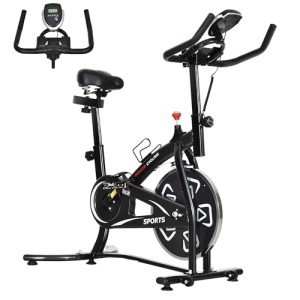20 Reasons To Believe Bicycle For Workout Will Not Be Forgotten
The Benefits and Mechanics of Using a Bicycle for Workout
Cycling, a versatile and effective type of exercise, has been gaining appeal as a low-impact, high-reward activity. Whether you're a seasoned professional athlete or a beginner seeking to enhance your fitness, riding a bicycle can provide a wide variety of health advantages. This post delves into the mechanics of cycling as a workout, its physical and psychological advantages, and offers pointers for beginning.
Introduction to Cycling as a Workout
Cycling is a low-impact, full-body exercise that can be adjusted to various fitness levels and objectives. It mostly targets the lower body, but it likewise engages the core and upper body, making it a thorough workout. Whether you're cycling outdoors on a road bike or indoors on a stationary bike, the advantages are various.
Physical Benefits of Cycling
Cardiovascular Health
- Cycling is an exceptional cardiovascular exercise that helps enhance heart health. It increases heart rate, enhances lung capacity, and improves circulation, lowering the risk of cardiovascular disease, stroke, and hypertension.
Muscle Strengthening
- Cycling mostly works the quadriceps, hamstrings, calves, and glutes. It likewise engages the core muscles for stability and the upper body for balance and steering. Routine cycling can lead to stronger, more toned muscles.
Weight Management
- Cycling is a high-calorie-burning activity. Depending upon the intensity and period, a 150-pound individual can burn around 500-800 calories per hour. This makes it an efficient tool for weight reduction and weight management.
Joint Health
- Unlike high-impact workouts like running, cycling is mild on the joints. It offers a low-impact method to stay active, making it appropriate for people with joint pain or injuries.
Improved Balance and Coordination
- Cycling needs balance and coordination, which can improve over time. click here for info can be especially beneficial for older adults or those recuperating from injuries.
Psychological Benefits of Cycling
Stress Reduction
- Cycling can be a meditative and relaxing activity. Home Exercise Bikes balanced motion and the outdoors can help lower stress and anxiety, promoting mental wellness.
Psychological Clarity
- Exercise, including cycling, releases endorphins, which are natural state of mind lifters. This can improve psychological clearness and cognitive function.
Increase in Confidence
- Achieving fitness goals, whether it's finishing a long ride or enhancing speed, can improve self-confidence and self-confidence.
Types of Bicycles for Workouts
Road Bicycles
- Developed for speed and effectiveness on paved roadways, road bikes are light-weight and have thin, smooth tires. They are perfect for long-distance rides and enhancing cardiovascular fitness.
Mountain Bicycles
- Constructed for off-road surface, mountain bikes have larger, knobby tires and a durable frame. They are excellent for building strength and endurance, particularly in sloping or rough surface.
Hybrid Bicycles
- Integrating components of road and mountain bikes, hybrid bikes use adaptability. They are appropriate for both paved and unpaved surface areas and are excellent for general fitness and travelling.
Stationary Bicycles
- Perfect for indoor workouts, stationary bikes can be changed for resistance and intensity. They are convenient for all weather condition conditions and can be utilized for interval training and high-intensity exercises.
Tips for Getting Started
Choose the Right Bike
- Select a bike that fits your fitness goals and convenience level. Consider elements like surface, distance, and budget.
Buy Safety Gear
- Always use a helmet, and think about other safety gear like gloves, knee pads, and reflective clothing, specifically if you're cycling outdoors.
Start Slow
- If you're brand-new to cycling, begin with brief, simple rides and gradually increase the duration and strength. This helps avoid injuries and construct endurance.
Stay Hydrated and Fueled
- Consume a lot of water before, throughout, and after your rides. Eat a well balanced diet plan to sustain your exercises and aid recovery.
Join a Community
- Consider signing up with a cycling club or group to stay motivated and satisfy like-minded people. This can likewise offer opportunities for group rides and training.
Frequently asked questions
Q: Is cycling a good workout for beginners?
- Yes, cycling is an exceptional workout for novices. It is low-impact, easy to discover, and can be adapted to different fitness levels. Start with short, easy trips and slowly increase the intensity and period.
Q: How often should I cycle for fitness?
- Aim for at least 150 minutes of moderate-intensity cycling per week, or 75 minutes of vigorous-intensity cycling. This can be broken down into much shorter, more regular sessions, such as 30 minutes, 5 times a week.
Q: Can cycling aid with weight-loss?
- Yes, cycling is a high-calorie-burning activity that can assist with weight loss and weight management. Integrate it with a healthy diet for best results.
Q: What are the best times to cycle for a workout?
- The best time to cycle depends upon your schedule and choices. Morning rides can help kickstart your metabolic process and boost energy levels, while night rides can be an excellent way to loosen up after a long day.
Q: Do I require special clothes for cycling?
- While you don't need special clothing, comfortable, breathable equipment is recommended. Think about cycling shorts for convenience and a moisture-wicking top to remain dry. If you're cycling outdoors, reflective clothes can improve visibility.
Cycling is a versatile and rewarding kind of exercise that offers many physical and psychological benefits. Whether you're cycling outdoors or inside, it can be customized to your fitness objectives and preferences. By choosing the ideal bike, investing in security gear, and following some basic suggestions, you can enjoy a satisfying and efficient workout. So, hop on a bike and begin pedaling your method to better health and well-being.
